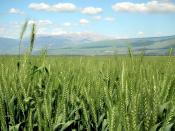Most rural farmers in India do not own a land by themselves. They are just workers of the uncivilized landowners. Their uneducated background makes the situation worsens as these people do not know their right. They need help from the government to educate them in term of their rights, lifestyle and most importantly, the proper farming knowledge.
The Green Revolution is no myth and thanks to the new seeds, ten of millions of extra tons of grain a year are being harvested. Does the Green Revolution actually proven to successfully ending the hungry people? Not Really.
The main problem of the traditional farming is farmers owns a fragmented lands. A small land does not yield a sufficient crops and limited cash for the next plantation. So many of these farmers borrow money from the moneylenders with high interest to purchase the seeds, fertilizers, etc to prepare for the next farming.
As the poor yields do not give them enough income to pay the moneylenders, they need to pay with their lands. Over the time, these farmers just become tenant farmers with small rewards.
The experiment of the ÃÂGreen RevolutionÃÂ was coined in the 1960s in Mexico. It proved in the test plots to improved varieties of wheat to increase yields. They are able to control the irrigation and to use petrochemical fertilizers allowing into producing more efficient food quantity. The ÃÂmiracle seedÃÂ was quickly spread to Asia and soon new strains of rice and corn were developed as well.
Another main factor is water. Irrigation is often out of the reach of the poor. Canal irrigation favours those near the top of the flow. Tubewells, often promoted by the development agencies and favour the bigger operators who can better afford the initial investment rather than having lower costs...



Short
I didn't really get this essay. Way off topic at times. Try again.
1 out of 1 people found this comment useful.